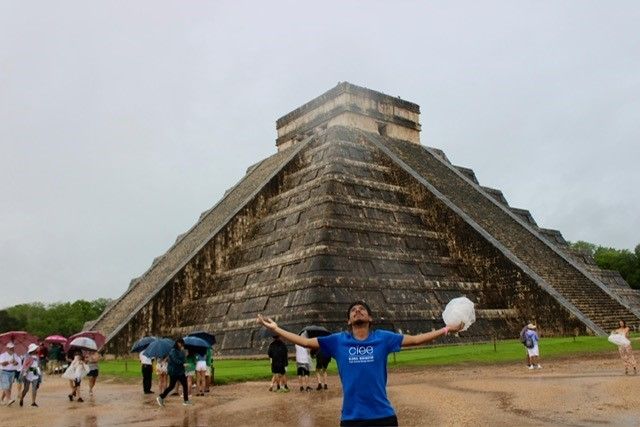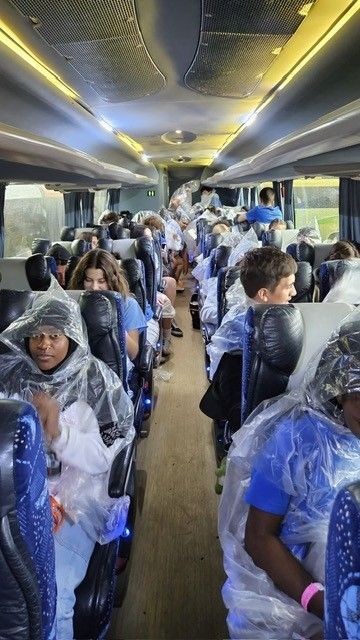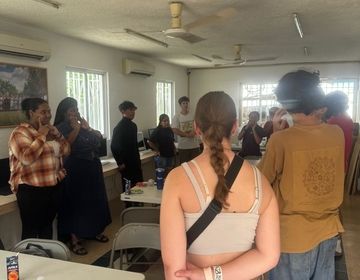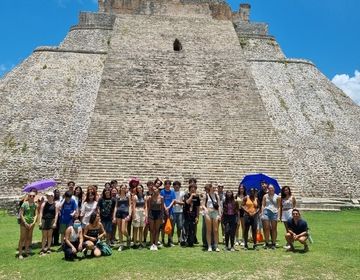Ruta Maya to Kukulkan, The Serpent!
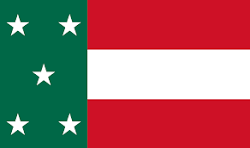
Today, as when the blended society of Mayans and Toltecs inhabited these lands, rain sweeps across the Pok-Ta-Pok grounds and winds whistle through the native flamboyantes, burning red against the charcoal skies.
The spirit of independence resonates against the seashell encrusted, hand chiseled, limestone walls of ancient edifices as our chauffeur dons the green, red, and white starred flag representing a still tangible sentiment - this peninsula is a uniquely autonomous region.
Blue clad CIEE student nomads and other archaeologically curious adventurers in hastily acquired rain smocks pose, smile and strategically angle I-Phones for selfies. Dismissive of the weather, they have gathered to honor Kulkukan and the Itzaes (“water-sorcerers”), and stride behind their tattooed Mayan descendents, now guides to the Wonder of the World: Chichen Itza.
Henry, our trilingual Mayan guide from the local indigenous population of Piste, shouts emphatically above wind blown sheets of relentless precipitation. He describes the bloody, regal account of the single goal scoring (and decapitated) warrior from the victorious side honored amongst the other engraved Pok-Ta-Pok heroes.
Our Mayan guide ceremonially produces a worn photograph: Henry as a 6 year old boy, standing atop the upper reaches of Kulkukan's impressive structures, hands held high. His childhood playground is now roped off into “áreas restringidas” - access forbidden.
Student Ulisses, a descendent of this genetically diverse southern section of North America, emulates Henry and the awe inspiring Itzaes, Toltecs, and Mayans, reaching towards the sky to embrace the precipitation.
The Itzaes succumbed to the Toltecs, succeeded by the Mayans - who ultimately fell prey to the Spaniards, driven by zeal for religious converts…and gold. The riches within the Yucatecan Peninsula have yet again sparked a flame in the hearts of the most recent conquering force: The Developers.
Over 1,550 kilometers of tracks have been laid, with over 20 stations connecting the major population centers of Quintana Roo, The Yucatan, Tabasco, Campeche, y Chiapas. Well guarded by federal militia, The Mayan Train, Ruta Maya, will carry goods and people deep into the jungle regions, to be freshly anointed at the Mayan Temples. Progreso and other ancient port cities will flood the market place with products.
New avenues of economic gain will be available to the strong willed peninsular residents.
Will the prize for this far-reaching project be the preservation and enrichment of the Mayan legacy…
Or the Pok-Ta-Pok's champion’s “honor by beheading” of the cultural integrity of the cenote filled, pyramid strewn, yet financially enticing region?
Viva Mexico! Viva The Yucatan!
Related Posts
Hacienda Yaxcopoil and Community Conversations
On Monday, students traveled to Hacienda Yaxcopoil to learn about the production of henequén, which is used to make products such as ropes, bags, and other crafts. Although henequén was... keep reading
Uxmal and ChocoStory Museum
This week, our students traveled to the archeological site of Uxmal, where they saw buildings and pyramids from the Mayan civilization. They also learned about the legend of Uxmal, in... keep reading
Cooking and the Zoo
This week has been busy! After our trip to Valladolid, we started the week off with a cooking class. Participants learned how to make chayitas, lomitos de Valladolid y arroz... keep reading
